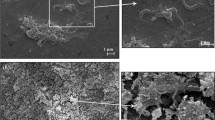Abstract
Present study is focused on the corrosivity of anaerobic treated distillery effluent and corrosion performance of mild steel and stainless steels. Accordingly, electrochemical polarization tests were performed in both treated distillery and synthetic effluents. Polarization tests were also performed in synthetic solutions and it was observed that Cl− and K+ increase whereas SO4 −, PO4 −, NO3 −, and NO2 − decrease the corrosivity of effluent at alkaline pH. Further, comparison in corrosivity of distillery and synthetic effluents shows the former to be less corrosive and this is assigned due to the presence of amino acids and melanoidins. Mild steel experienced to have the highest corrosion rate followed by stainless steels—304L and 316L and lowest in case of SAF 2205. Relative corrosion resistance of stainless steels is observed to depend upon Cr, Mo, and N content.







Similar content being viewed by others
References
R. Sowmeyan and G. Swaminathan, Effluent Treatment Process in Molasses-Based Distillery Industries: A Review, J. Hazard. Mater., 2008, 152(2), p 453–462
A. Iversen, Microbially Influenced Corrosion on Stainless Steels in Wastewater Treatment Plants: Part1, Br. Corros. J., 2001, 36(4), p 277–283
A. H. Tuthill and S. Lamb, Stainless Steel in Municipal Wastewater Treatment Plant, Nickel Development Institute, NiDI Technical Series 10076, 2007
C. Ram, C. Sharma, and A.K. Singh, Electrochemical Corrosion Investigations on Distillery Effluent, 2013, submitted for publication
G.E. Englert and I.L. Muller, The Corrosion Behaviour of Mild Steel and Type 304 Stainless Steel in Media from an Anaerobic Biodigestor, Int. Biodeterioration Biodegrad., 1996, 37(3–4), p 173–180
P. Perego, B. Fabiano, R. Pastorino, and G. Randi, Microbiological Corrosion in Aerobic and Anaerobic Waste Purification Plants: Safety and Efficiency Problems, Bioprocess Eng., 1997, 17(2), p 103–109
C. Dave, R. Craig, and D. Bacon, Corrosion in Secondary Effluent Treatment Systems, NACE International Corrosion Conference, New Orleans LA, 2004
R.S. Kurissery, K. Hirotani, and Y. Kikuchi, Microbiologically Influenced Corrosion Failure of AISI, Type 304 Stainless Steel in a Wastewater Treatment System, NACE International Corrosion, New Orleans, LA, 2004
T. Sasikala and B.R. Babu, Corrosion Behaviour of Medium Carbon Steel in Paint Industrial Effluent, IUP J. Chem., 2010, 3(2), p 58–62
Z. Shen, H. Ren, K. Xu, J. Geng, and L. Ding, Inhibition Effect of Phosphorus-Based Chemicals on Corrosion of Carbon Steel in Secondary-Treated Municipal Wastewater, Water Sci. Technol., 2013, 67(11), p 2412–2417
ASTM, Wear and Erosion, Metal Corrosion, American Society Testing and Material Standard, 3rd edn., Vol. 2, 1991, p G1-72
APHA, Standard Methods for the Examination of Water and Wastewater, 17th edn, Washington DC, 1989
S. Mohana, B.K. Acharya, and D. Madamwar, Distillery Spent Wash: Treatment Technologies and Potential Applications, J. Hazard. Mater., 2009, 163(1), p 12–25
P.K. Chaudhari, R. Singh, I.M. Mishra, and S. Chand, Kinetics of Catalytic Thermal Pre-Treatment (Catalytic Thermolysis) of Distillery Wastewater and Bio-Digester Effluent of Alcohol Production Plant at Atmospheric Pressure, Int. J. Chem. Reactor Eng., 2010, 8(1), p 1–22
M. Pourbaix, Atlas of Electrochemical Equilibria in Aqueous Solution, 2nd edn., 1974, Houston, TX
M.A.M. Ibrahim, S.S.A.E. Rehim, and M.M. Hamza, Corrosion Behaviour of Some Austenitic Stainless Steels in Chloride Environments, Mater. Chem. Phys., 2009, 115(1), p 80–85
M. Saadawy, Kinetics of Pitting Dissolution of Austenitic Stainless Steel 304 in Sodium Chloride Solution, ISRN Corrosion, 2012, Article ID 916367, p 1-5
G. Kilincceker, B. Yazici, and M. Erbil, The Effect of Phosphate Ions (PO −34 ) on the Corrosion of Iron in Sulphate Solutions, Turk J. Chem., 1999, 23, p 41–50
J. Pettersson, H. Asteman, J.-E. Svensson, and L.-G. Johansson, KCl Induced Corrosion of A 304-Type Austenitic Stainless Steel at 600 °C; the Role of Potassium, Oxid. Met., 2005, 64(1-2), p 23–41
M.R. Choudhury, M.-K. Hsieh, R.D. Vidic, and D.A. Dzombak, Corrosion Management in Power Plant Cooling Systems Using Tertiary-Treated Municipal Wastewater as Makeup Water, Corros. Sci., 2012, 61(1), p 231–241
R.K.S. Raman and W.H. Siew, Role of Nitrite Addition in Chloride Stress Corrosion Cracking of a Super Duplex Stainless Steel, Corros. Sci., 2010, 52(1), p 113–117
R.C. Newman and M.A.A. Ajjawi, A Micro-Electrode Study of the Nitrate Effect on Pitting of Stainless Steels, Corros. Sci., 1986, 26(12), p 1057–1063
T. Yamasaki, T. Aki, M. Shinozaki, M. Taguchi, S. Kawamoto, and K. Ono, Utilization of Shochu Distillery Wastewater for Production of Polyunsaturated Fatty Acids and Xanthophylls Using Thraustochytrid, J. Biosci. Bioeng., 2006, 102(4), p 323–327
A.A. Aksüt and S. Bilgiç, The Effect of Amino Acids on the Corrosion of Nickel in H2SO4, Corros. Sci., 1992, 33(3), p 379–387
A. Simaratanamongkol and P. Thiravetyan, Decolorization of Melanoidin by Activated Carbon Obtained from Bagasse Bottom Ash, J. Food Eng., 2010, 96(1), p 14–17
R. Chandra, R.N. Bharagava, and V. Rai, Melanoidins as Major Colourant in Sugarcane Molasses Based Distillery Effluent and its Degradation, Bioresour. Technol., 2008, 99(11), p 4648–4660
I. Alvarez-Armas, Duplex Stainless Steels: Brief History and Some Recent Alloys, Recent Patents Mech. Eng., 2008, 1(1), p 51–57
J.W. Simmons, Overview: High-Nitrogen Alloying of Stainless Steels, Mater. Sci. Eng., 1996, A207(2), p 159–169
H.J.C. Speidel and M.O. Speidel, Nickel and Chromium-Based High Nitrogen Alloys, Mater. Manuf. Process., 2004, 19(1), p 95–109
Acknowledgment
Mr. Chhotu Ram is highly thankful to the Ministry of Human Resource Development (MHRD) New Delhi, India for the financial research grant for pursuing Ph.D. work.
Author information
Authors and Affiliations
Corresponding author
Rights and permissions
About this article
Cite this article
Ram, C., Sharma, C. & Singh, A.K. Electrochemical Corrosion Investigations on Anaerobic Treated Distillery Effluent. J. of Materi Eng and Perform 23, 3321–3327 (2014). https://doi.org/10.1007/s11665-014-0960-5
Received:
Revised:
Published:
Issue Date:
DOI: https://doi.org/10.1007/s11665-014-0960-5




